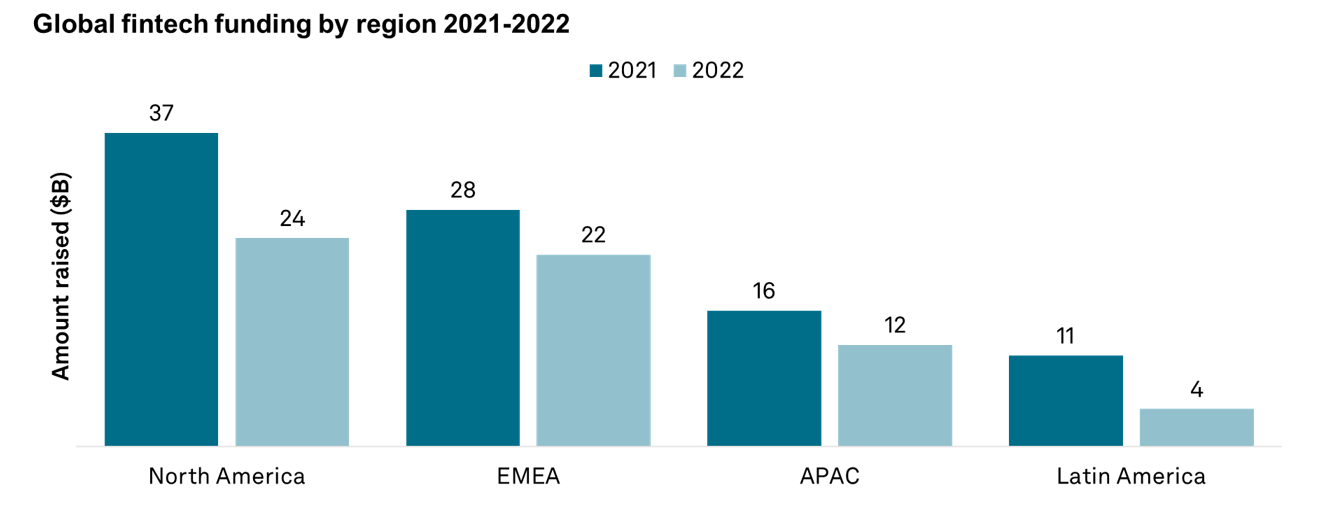S&P Global Offerings
Featured Topics
Featured Products
Events
S&P Global Offerings
Featured Topics
Featured Products
Events
S&P Global Offerings
Featured Topics
Featured Products
Events
Banking & Capital Markets
Economy & Finance
Energy Transition & Sustainability
Technology & Innovation
Podcasts & Newsletters
Banking & Capital Markets
Economy & Finance
Energy Transition & Sustainability
Technology & Innovation
Podcasts & Newsletters
S&P Global Offerings
Featured Topics
Featured Products
Events
Research — 14 Apr, 2023
A broad-sweeping downturn in the technology sector led fintech funding to fall by a third globally to $63 billion in 2022, according to S&P Global Market Intelligence’s Global Fintech Funding Trends report. Fintech funding saw a massive deceleration in the last quarter of 2022, registering only 599 rounds for $8 billion, compared to nearly 1,000 rounds worth $26 billion in the year-ago period. The current uncertainty, amplified by the mid-March collapse of Silicon Valley Bank, will likely sink the amount of capital raised by fintechs this year to where it was in 2020 when COVID-19 brought much of the world to a standstill.
The Take
A challenging macro environment will likely nudge venture capitalists (VCs) and startups to go back to the drawing board to reassess their risk tolerance and the market opportunity. Across financial verticals, we expect investor rotation into B2B and out of B2C to accelerate in 2023. A geographical rotation could be in the cards as well, with VCs scouting for less-crowded parts of the world where traditional finance remains essentially non-existent. Payments orchestration, cross-border payments, sweep networks providing access to an array of banking relationships and revenue financing could be among attractive fintech models. Middleware players inhabiting the embedded finance space appear to be safe bets as well.
Leading markets
As fintech-focused venture capitalists turned off the equity spigots in 2022, Latin America witnessed the sharpest fall in funding at 59%, followed by North America at 34%. EMEA and APAC regions contracted 19% and 25%, respectively.
Fintech funding value declined across regions in 2022

Source: S&P Global Market Intelligence, 2023.
The share of global venture capital attracted by individual countries somewhat correlated with their share of global GDP. However, it heavily skewed in favor of the US, the UK and India. The three markets pulled more than half of fintech funding from 2021 to 2022, while representing only one-third of the global GDP.
The US saw fintechs raise $23.59 billion in 2022, down 31% from $34.31 billion in 2021. Fintech funding in the UK came in at $10.19 billion in 2022, down from $12.4 billion in 2021, while Indian fintechs collectively raised $3.62 billion, down from $5.76 billion.
The Southeast Asian region, comprising Singapore, Indonesia, Malaysia, Thailand, the Philippines and Vietnam, has emerged as the fourth most crucial hub for fintech-focused venture capitalists, drawing in $5.4 billion, nearly flat relative to 2021.
Africa was among the few markets to buck the downturn and register a slight rise in fintech investments, albeit on a low base. African fintechs garnered $1.26 billion in 2022, up from $1.11 billion in 2021. The Middle East, another rising fintech hub globally, witnessed a slight decline in fintech funding to $1.47 billion in 2022 from $1.59 billion in 2021.
Fintech verticals
Among fintech verticals, payments saw the brunt of the decline, with aggregate funding value falling to $19 billion from $30 billion in 2021. Robust digital payment trends could encourage VCs to continue to support category leaders, but capital will likely come with strings attached.
Funding to digital lenders fell by about a fifth to $11 billion in 2022. In developed economies, the inherent advantages of buy now, pay later compared to other consumer financing options are likely to diminish in the near term amid rising interest rates and high inflation. However, in developing countries, where traditional credit is in limited supply, digital lenders acquiring high-quality borrowers and maintaining low delinquencies are primed to grow.
The banking technology vertical comprising licensed digital banks and fintechs without banking charters (neobanks) saw the highest percentage decline in funding (42%), dropping to $10 billion. However, following the collapse of Silicon Valley Bank, fintechs could scoop up new clients due to a greater propensity among businesses to work with platforms touting fast account opening, payroll integration and instant access to funds. An industry-wide shift toward optimizing costs and growth could also lead to a more favorable outlook for fintech-as-a-service providers, a segment alternately referred to as embedded finance.
Notably, seed rounds became hotter in 2022, a trend that may persist this year. The round size in the seed space grew by 40% on average as VCs kept the tap open for firms at the earliest stage of entrepreneurship.
Methodology
S&P Global Market Intelligence’s Global Fintech Funding Trends report details venture capital activity in 2021 and 2022 and highlights leaders in various fintech verticals and geographies. Our analysis leverages S&P Global Market Intelligence’s private placement transaction data for privately held fintechs. It covers all equity-focused venture rounds and excludes transactions categorized as debt. The transaction dates reflect the assumed closing date of the offering as of the time the data was compiled, but some rounds might be subsequently extended. We use a best-effort approach to identify and validate fintech funding rounds and to determine appropriate fintech verticals by reviewing company websites, press releases, filings and media reports.
Podcast
Report
